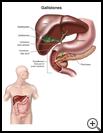
Cholecystitis
________________________________________________________________________
KEY POINTS
- Cholecystitis is swelling and irritation of the gallbladder. The liver and gallbladder are part of your digestive system. Cholecystitis is usually caused by gallstones or by bile staying in the gallbladder too long.
- Usually, gallstones need to be removed with surgery. Surgery may also remove your gallbladder to prevent future problems.
- Ask your healthcare provider how long it will take to recover if there are activities you should avoid and when you can return to your normal activities.
________________________________________________________________________
What is cholecystitis?
Cholecystitis is swelling and irritation of the gallbladder.
The liver and gallbladder are part of your digestive system. The liver makes bile that helps your body break down the fat in food. Ducts carry bile from the liver to the gallbladder and small intestine. The gallbladder is a small sac under your liver on your right side that stores bile.
What is the cause?
Cholecystitis is usually caused by gallstones or by bile staying in the gallbladder too long.
- Gallstones are hard stone-like objects that build up in the gallbladder. They can be as small as a grain of sand to as large as a golf ball. Gallstones may stay in the gallbladder or smaller stones may move into the bile ducts. If stones completely block the common bile duct, the flow of bile out of the liver can also be blocked. This causes swelling, irritation, and pain in your liver, your gallbladder, or both.
- If bile stays in the gallbladder too long, the bile gets thick. This can happen because of a blockage, long-term fasting, damage to your gallbladder, certain medicines you take, or other health problems. Thick bile irritates the gallbladder and can cause swelling or an infection.
If not treated, swelling can cause your gallbladder to burst, or you could get a serious infection. Both can be life-threatening.
Sometimes cholecystitis is caused by injury, surgery, or an infection in another part of your body.
What are the symptoms?
Symptoms may include:
- Pain in the upper right part of the belly or in the upper back between the shoulder blades or in the right shoulder. Pain may be severe and may last several hours.
- Sweating, nausea, and vomiting
- Chills and fever
If you are having pain due to a gallstone that is stuck in the bile duct, your symptoms will continue until the stone moves into your intestines or you have surgery.
How is it diagnosed?
Your healthcare provider will ask about your symptoms and medical history and examine you. The most common tests to diagnose cholecystitis are:
- An ultrasound, which uses sound waves to show pictures of your gallbladder and bile ducts
- CT scan, which uses X-rays and a computer to show detailed pictures of your gallbladder and bile duct
Other tests may include:
- Blood tests
- X-rays
- Nuclear scans, which use a small amount of contrast dye injected into your vein to show how well bile flows from your liver, through your gallbladder, and into your small intestine.
How is it treated?
Usually, gallstones need to be removed with surgery. Surgery may also remove your gallbladder to prevent future problems. Removal of your gallbladder should cause few, if any, long-term problems because your digestive system can work well without it. You may have looser bowel movements after its removal.
Surgery may be done in two ways:
- Laparoscopic surgery is done through several small cuts in the belly. A laparoscope is a lighted tube with a camera. Your provider can put the scope and tools into your belly through the small cuts.
- Open surgery (with bigger cuts in the belly) may be needed to safely remove the stones.
How can I take care of myself?
Ask your healthcare provider:
- How and when you will get your test results
- How long it will take to recover
- If there are activities you should avoid and when you can return to your normal activities
- How to take care of yourself at home
- What symptoms or problems you should watch for and what to do if you have them
Make sure you know when you should come back for a checkup. Keep all appointments for provider visits or tests.
How can I help prevent cholecystitis?
Some causes of cholecystitis cannot be prevented. To help prevent cholecystitis cause by gallstones:
- Get your cholesterol levels and weight checked regularly. Lose weight if you are overweight.
- If you are extremely overweight and need to follow a very low calorie diet for quick weight loss, your healthcare provider may prescribe medicine to help prevent gallstones.
- Eat a diet that is low in saturated fat, trans fat, and cholesterol. Eat healthy foods that are high in fiber, such as whole grains, fresh fruits, and vegetables.
- Get more exercise. Ask your provider to give you a physical activity plan that tells you what kind of activity, and how much, is safe for you. Start slowly to avoid injury.
- Avoid fasting. Long periods of fasting can cause gallstones because the bile stays in the gallbladder too long.

